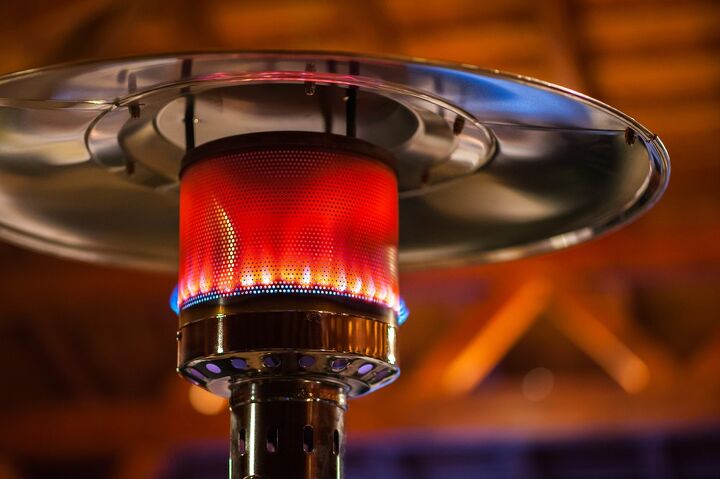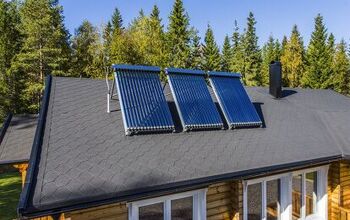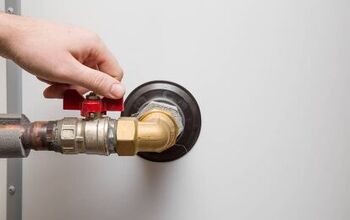Infrared Patio Heater Vs. Propane: Which One Is Better?

My backyard is one of my favorite spaces in or outside of my house. My family and I spend tons of time out there in the summer especially. So, it’s kind of a bummer when the weather changes and we can no longer enjoy the little oasis we’ve created.
Luckily, there’s a fix for that! Patio heaters are growing in popularity, particularly in the midst of the pandemic. They’re a perfect solution for those who want to get their outdoor fix even in cooler temperatures. But the choices can be overwhelming. Choosing the right patio heater for you means knowing which type of heat will work best for your needs.
The biggest benefit of infrared patio heaters is their efficiency. They work fast because they create heat just like the sun, absorbing into your skin and creating instant warmth. But you must be directly in front of one in order to feel the heat. Propane heaters also heat quickly, though not as quickly as infrared heaters. They are usually portable and are typically less expensive.
Do You Need a Heating and Cooling Contractor?
Get free, zero-commitment quotes from pro contractors near you.

Infrared Heaters
These heaters work just like the sun, minus the harmful UV rays. They use radiation to heat objects before heating the surrounding air, creating instantaneous warmth for people in their direct path. In fact, 100% of the heat they project is focused directly on objects.
They don’t burn any fuel so they are a safe and healthy option. Because most infrared heaters run on electricity, they end up being more expensive. Electric heat is the most expensive type. They can also be powered by natural gas or propane.
They can be found in multiple shapes and sizes, including options for floor-standing, ceiling-hung, or wall/pole-mounted.
A Note on Heat Radiation
Infrared heaters use radiant heat, but don’t be alarmed. Heat radiation is actually a very common occurrence. If the surrounding area is cooler, a warm object will radiate heat. On the other hand, an object will absorb the radiant heat of warmer objects surrounding it.
Infrared heaters use a very safe and natural way of heating. The heat they radiate is in no way dangerous to your health.
Propane Heaters
This type of heater uses propane as a fuel source for creating heat. The heat then blows out into the surrounding air, creating warmth in the overall space. Propane heaters differ from infrared heaters in that they heat the air first rather than targeting objects.
Along with being quite affordable, propane is also portable. It can be used almost anywhere without the need for natural gas or electrical hook-up.
They come in two different types: standing and tabletop. Standing heaters are great for larger spaces as they can be moved to accommodate the setup. Tabletop heaters work well in more intimate settings as they heat a smaller space.
Pros and Cons of Infrared Heaters
In terms of the advantages and disadvantages of infrared heaters, the pros definitely outweigh the cons.
Pros
- The heat is instantaneous from the minute it turns on, so you feel warm immediately.
- They are highly efficient.
- They are durable and versatile. You can use them pretty much anywhere—inside and outside.
- Because they don’t burn any fuel, they don’t emit any harmful compounds, making them a healthier and safer option.
- Maintenance costs are low.
- They are available in smaller sizes that are portable.
Cons
- You can only feel its warmth when in the direct path of its heat. If you move anywhere outside, you’ll instantly be cold. In the same vein, nothing can block the heater (furniture, other people, etc.) or you won’t feel the heat.
- Gas-fired infrared heaters cannot be left unattended or it’s considered a safety hazard. Although unlikely, a gas leak could occur, which would be dangerous if left unattended.
- Some units are hot to the touch, so it’s important to be careful around them to avoid injury.
- Because many infrared heaters are electric, they are more costly since that is the most expensive type way to heat a space.
Pros and Cons of Propane Heaters
Propane heaters also have many benefits which makes them a popular option for consumers.
Pros
- They heat the air within an hour.
- They are typically portable.
- The cost to replace a tank is relatively low. Tanks are also easy to acquire.
- A propane tank can last for 6-10 hours.
- A portable propane heater takes up hardly any space.
Cons
- The tank will have to be refilled periodically.
- It takes longer to feel the heat because it’s heating the air and not the object.
- Many standing propane heaters have a minimum ceiling height requirement in order to be run safely.
- It’s recommended not to use a propane heater under an awning or on a covered porch.
- They are less wind-resistant than infrared heaters because the airflow affects how the heat is dispersed.
What to Consider When Buying a Patio Heater
Before you buy a patio heater, there are some variables to consider. You’ll want to pay attention to the size of the space and the heater, how much power the heater will put out, and its safety features.
Size
How big is the square footage of the space you want to heat? That’s the most important thing when determining what size patio heater to buy. If you’re heating a smaller space, you’ll want a smaller, portable model. For a larger space, a standing or tower heater will produce more heat.
All heaters have a minimum clearance around and above them to ensure proper ventilation for safety. You need to keep those clearances in mind when looking at placement within the space.
Power
You want to make sure the power of heat given off by the heater is appropriate to the amount of space you’re heating. A general rule for this calculation is to multiply the space’s square footage by 10. For example, if your space is 100 square feet, you would need a 1000-watt heater.
Infrared heaters use various elements to release infrared rays. These elements include quartz, ceramic, and carbon. Each element has a different level of energy efficiency and can affect how much heat is put out.
Safety Features
Many patio heaters come equipped with automatic features to ensure the safety of their users. Keep an eye out for some of the following features:
- Automatic shut-off when overheating, tilted, or tipped
- Timers that automatically shut off the unit after a period of time
- Casings that are cool to the touch
Related Questions
After weighing the pros and cons of infrared and propane heaters, you may still have some questions. Here are several questions that other people asked related to safety, cost, and usage of infrared or propane heaters.
Can you use a patio heater under a covered patio?Most outdoor heaters are safe to use under a covered patio assuming you have the proper clearances laid out by the manufacturer. If you are unsure, check the manual or manufacturer’s guide.
Infrared heaters distribute heat sideways, so they typically require only a foot of ceiling clearance. Most other types of patio heaters require a three-foot clearance above and two feet on each side.
Can infrared heaters cause health problems?Although we mentioned this earlier, it’s a noteworthy topic in which to dive deeper. While infrared heaters do use radiation, it is completely different than radiation used in X-rays and microwaves. Infrared heaters heat the same way the sun does, but do not carry harmful UV rays. So, no. They are not dangerous to your health.
Can infrared heaters cause fires?Infrared heaters will not cause fires or explosions because they do not burn fuel. Heater fires are caused when fossil fuels like kerosene or propane emit pollutants like carbon monoxide, which is highly flammable.
How much propane does a patio heater use?On average, a portable propane patio heater holds a 20lb tank. This is about 4.7 gallons of fuel. This size tank can last for up to 10 hours. It costs between $15-$20 to fill up the tank, which makes the average cost per hour between $1.70-$2.00.
Do You Need a Heating and Cooling Contractor?
Get free, zero-commitment quotes from pro contractors near you.

Which One is Better?
Both infrared and propane heaters have a great many benefits. They also have their pitfalls. As you do your research, you should consider the size of your space, the power of the heater, and the safety features they offer.
While propane heaters are more popular at the moment, infrared heaters are making a name for themselves. Infrared heaters are the more versatile choice, but they are more expensive overall. They give off a more concentrated heat that, if placed properly, will keep people warmer in colder temperatures.
If you’re unsure whether you want a patio heater in general, you can get a portable propane heater at a small cost to see if you like it. If you do, you can always get a more permanent solution at a later time.
Related Guide

Brigid Levi is a wife, mother, and freelance writer who enjoys a good DIY project and creating beautiful spaces within her home. From cleaning and organization hacks to home decor ideas, she loves helping people in their quest to turn a house into a home. Her hobbies include pretending to be Joanna Gaines while updating her home with her husband and performing in local theater productions.
More by Brigid Levi



























